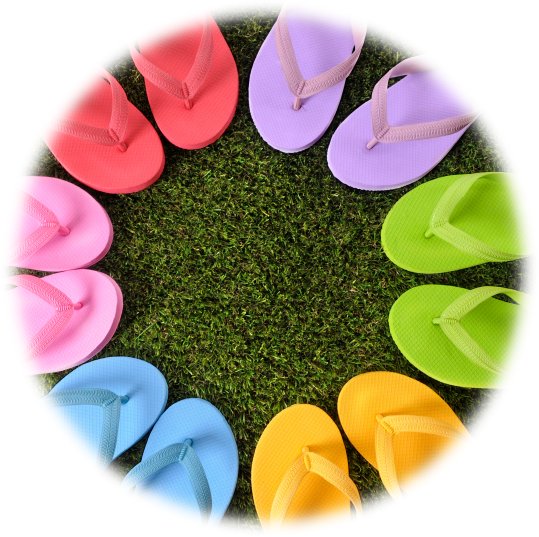
For today's stroll you get to kick off your sneakers, boots, high heels or whatever and wear flip flops!
Flip Flops

There was a time when I had to give them up because of foot surgery and I was in pure hell..but I'm good to go now. Last summer I went to the 99 cent store and got them in every color they had; in fact I bought two of each!
Does anyone else remember when we called them thongs? That was before thongs meant something entirely different for a whole different body part, oh my!!

For some, summer is all about the wedge, or even the gladiator, but for most of us – we’ll admit it – we’ll spend May thru September wearing our flip flops.
The simplest of footwear designs, just a flat footbed attached to a Y-shaped thong, the modern rubber flip flop is thought to have originated from a Japanese style called the zori. After soldiers returning from World War II brought them home from Japan as souvenirs, they were marketed towards women as slippers to be worn with their housecoats. They were named “jandals,” blending the words “Japanese” and “sandal.” When John Cowie, a Hong Kong based businessmen began manufacturing cheap rubber versions, the style quickly caught on with beach goers in the 1950s and 1960s.

But they've been around long before the Japanese... Thong sandals have been worn for thousands of years, dating back to pictures of them in ancient Egyptian murals from 4,000 BC. A pair found in Europe was made of papyrus leaves and dated to be approximately 1,500 years old. These early versions of flip-flops were made from a wide variety of materials. Ancient Egyptian sandals were made from papyrus and palm leaves. The Masai of Africa made them out of rawhide. In India, they were made from wood. In China and Japan, rice straw was used. The leaves of the sisal plant were used to make twine for sandals in South America, while the natives of Mexico used the yucca plant.

The Ancient Greeks and Romans wore versions of flip-flops as well. In Greek sandals, the toe strap was worn between the first and second toes, while Roman sandals had the strap between the second and third toes. These differ from the sandals worn by the Mesopotamians, with the strap between the third and fourth toes. In India, a related chappal ("toe knob") sandal was common, with no straps but a small knob sitting between the first and second toes. They are known as Padukas.
I'll bet you all had no idea that your flip flops are a big part of history.
All you need to do to figure out why we call them "flip-flops" is to walk around in a pair of them for just a little while. Because of how they're made, the rubber soles slap against the bottom of your feet as you walk, making a flip-flop, flip-flop sound. The name “flip-flop" is thus an example of onomatopoeia.

Onomatopoeia means a word or a thing's name comes from the sound that it makes.
See there, stick around you might just learn something...
But for now put on your flip flops and get off that computer and have a great summer!

Strolling Down Memory Lane with Candy - Main Page
My Compliments to Candy on Flip Flops